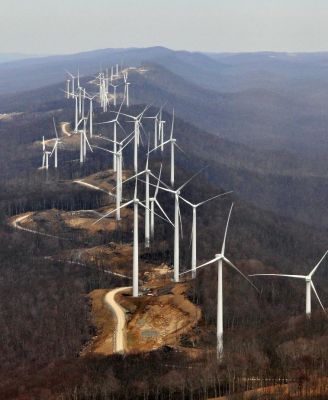| Wind Watch is a registered educational charity, founded in 2005. |
Measuring the Performance of Wind Energy Projects
Author: | Economics, Emissions, Environment
Translate: FROM English | TO English
Translate: FROM English | TO English
Assuring the Success of the Commonwealth Energy Policy
The General Assembly has found that energy is essential to the health, safety, welfare and economy of the Commonwealth and that state government should facilitate the availability and delivery of reliable and adequate supplies of energy to industrial, commercial, and residential users at reasonable costs. The General Assembly has also enumerated energy objectives (§ 67-101), set forth a Commonwealth Energy Policy (§ 67-102), and directed development of a non-regulatory Virginia Energy Plan (§ 67-201). Among the objectives addressed by the Code is promotion of alternative energy sources, which, compared to traditional energy resources, may be less polluting of the Commonwealth’s air and waters. Alternative energy includes electricity generated through the use of wind turbines.
Although the Commonwealth has no experience with commercial-scale wind energy projects, the General Assembly has sought to promote the development of such projects through expedited environmental permitting by establishment of a Permit By Rule administered by the Department of Environmental Quality (§ 10.1-1197.6). In addition, the General Assembly has directed the State Corporation Commission to approve increased consumer electricity rates for utilities that demonstrate attainment of the Commonwealth’s
Renewable Portfolio Standard (§ 56-585.2). Fortunately, the General Assembly has also recognized the need to establish a procedure for measuring the implementation of the Commonwealth Energy Policy (§ 67-100). It makes sense to assure that the desired benefits of energy production are obtained, that harm to the public interests are minimized, and that future revisions of the Virginia Energy Plan are informed by experience and data.

The General Assembly may have been well-intentioned in promoting wind energy development in the mix of alternatives, but new information about the efficacy of commercial-scale wind energy generation indicates that objective prediction and verification of performance is warranted.
- The 2010 Virginia Energy Plan estimates the costs of new electricity generation sources, including wind generation facilities. Based on data provided for new facilities entering service in 2016, the cost of electricity generated with onshore wind projects will be 49% greater than the cost of electricity generated with conventional coal-fired power plants and 25% greater than the cost of electricity generated with nuclear power plants. (Virginia Department of Mines, Minerals, and Energy 2010. The Virginia Energy Plan, www.dmme.virginia.gov/DE/VAEnergyPlan/VEP-2010.shtml)
- Although the National Research Council predicted in 2007 that onshore wind energy development may offset carbon emissions by a small amount, a 2010 report by Bentek Energy, LLC reached a different conclusion. Research presented in the report suggests that contrary to expectations and the objectives of Colorado’s Renewable Portfolio Standard, wind energy development has resulted in increased emissions of sulfur, nitrogen, and carbon. This undesirable result is attributed to the inefficient management of coal-fired power plants that is required to accommodate the variable and intermittent electricity generation achieved by wind turbine facilities. (Bentek Energy, LLC, 2010. How Less Became More: Wind, Power, and Unintended Consequences in the Colorado Energy Market, www.bentekenergy.com)
- A 2007 report by the National Research Council projected that U.S. onshore wind power development through 2020 will achieve no reduction in demand for electricity from other sources, will provide no reduction in sulfur and nitrogen emissions, and may offset carbon dioxide emissions by only 1.2 to 4.5% from the levels of emissions that would otherwise occur from electricity generation. The report further concluded that because the density of the onshore wind resource is less for the Mid-Atlantic region states than for the country as a whole, the benefits in terms of electricity supply and emissions reductions will be less than for the country as a whole. (NRC, 2007. Environmental Impacts of Wind Energy Projects, National Academy Press, www.nap.edu/catalog/11935.html)
Determination of both the projected and realized performance of wind energy generation projects is absolutely necessary in the proper administration of state incentives and licensing.
Wind energy generation projects must be subject to SCC licensing and the requirement to obtain a certificate of convenience and necessity.
SCC approval of wind energy generation facilities should further be conditioned upon provision of:
- analysis that objectively calculates the costs and benefits of proposed wind energy projects
- annual reports that document the performance of installed wind energy projects
These analyses and reports should be based on publically reviewable data and methods that quantify effects on the reliability of electricity service and costs to consumers, electricity generation on an annual and monthly basis and during peak demand periods, and reductions in air pollution obtained through displacement of electricity generation by traditional energy sources. Prior to issuance of any licensing action under Title 56, the SCC must verify that the data and calculations concerning these costs and benefits are credible and accurate and that proposed projects are necessary and in the public interest.
Finally, it is imperative that future periodic revisions of the Virginia Energy Plan incorporate knowledge and experience gained from existing wind energy projects and that plan revisions be subject to public review and comment.
This material is the work of the author(s) indicated. Any opinions expressed in it are not necessarily those of National Wind Watch.
The copyright of this material resides with the author(s). As part of its noncommercial educational effort to present the environmental, social, scientific, and economic issues of large-scale wind power development to a global audience seeking such information, National Wind Watch endeavors to observe “fair use” as provided for in section 107 of U.S. Copyright Law and similar “fair dealing” provisions of the copyright laws of other nations. Queries e-mail.
| Wind Watch relies entirely on User Funding |
 (via Stripe) |
 (via Paypal) |
Share:
Tags: Wind power, Wind energy

